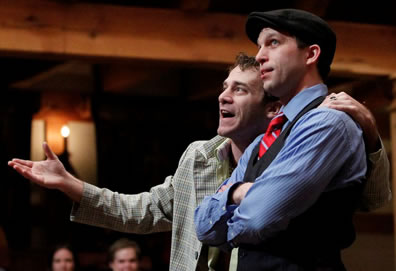A Trick to Catch the Old One
Tricks to Catch the New Ones
with an Old One
By Thomas Middleton
American Shakespeare Center, Blackfriars Playhouse, Staunton, Va.
Friday, March 18, 2011, A– 3&4 (front stalls)
Actors’ Renaissance Season
The old saying contends that too many cooks spoil the broth. However, 13 talented and fearless actors can concoct a Renaissance remoulade sauce that no single male or female mind could conceive. Unless it was a crazy, crazy mind.

Tyler Moss as Harry Dampit converses with Gregory Jon Phelps' Theodorus Witgood in A Trick to Catch the Old One at the Blackfriars Playhouse. Photo by Tommy Thompson, American Shakespeare Center.
Middleton’s parable of greed and lust in circa 1605 London is a comedy of broad brush-stroked characters and unsubtle jokes. It does have a heart in the relationship between the two protagonists, Theodorus Witgood (Gregory Jon Phelps), a deep-in-debt spendthrift, and Jane (Miriam Donald), a courtesan masquerading as a rich widow. She is his mistress, but for financial reasons (and in a genuine care for each other), they set off on a con game that would land each of them separately in matrimonial states of wealth and respectability (actually they end up in an aunt-nephew relationship).
They gull his uncle, Pecunius Lucre (John Harrell), into not only paying off Witgood’s debts but unwittingly financing his courtship of Joyce (Sarah Fallon), niece to Lucre’s “mortal enemy” Walkadine Hoard (Benjamin Curns). Meanwhile, they gull Hoard into marrying the courtesan Jane. At the end, both reckless spender and prostitute repent their sinful ways and through their redemption bring a state of familial forgiveness for everybody, including the two old rivals. It could be a parable for this age of Wall Street excess.
Perhaps a director may want to explore that link in a dark-humored production. In the Actors’ Renaissance Season, when left to flesh out their own parts and raising the standard of ensemble acting to the highest plane, this repertory company merged Middleton into Married with Children: bawdy naughtiness, over-the-top portrayals, and excess of sight gags. Curns and Harrell as upper crust Victorians (everybody else was in modern dress) yapped at each other like affronted Chihuahuas. Donald was sweet and sexy, and Phelps was sweet and savvy. Chris Johnston as Witgood’s friend orchestrated the con plot like a nifty stage manager. Patrick Midgley as the ancient Kix emitted a cackling laugh returned hundredfold from the audience. Tyler Moss as the drunken userer Harry Dampit was smarm personified.
Two gags elicited ovations. After greeting Jane with a hesitating (but desiring) kiss on the lips, Harrell’s Lucre instructed his wife, Lady Foxstone (Allison Glenzer) to greet her in like fashion. Glenzer, with a hitherto ever-bored expression, planted a long, lusty kiss on the other woman, then returned to her “whatever” demeanor. Then there were Witgood’s Creditors, played by Jeremiah Davis, Paul Jannis, and Jeremy West in a choreography of mafioso movements. Given that this was opening night and the troupe had mounted the production in only seven days (while performing four other plays), the trio’s perfectly timed movements were a measure of the actors’ skills and camaraderie, their collective performance climaxing with an “All” speech delivered in perfect unison to different sections of the house like a creep chorus. As they departed to applause, Curns as Hoard entered on the opposite side and offered some token bows, taking the ovation to be for himself.
It was this combination of skilled acting, good-time presentation, and broad Renaissance comedy that had the audience, comprising mostly young adults, laughing and clapping all night. Afterward, flipping through my mental Rolodex of snapshot scenes and moments from the play, all I could say was, “Man, that was crazy.”
Eric Minton
March 20, 2011
Comment: e-mail [email protected]
Start a discussion in the Bardroom


